Introduction
In the realm of data analysis, mastering the intricacies of DAX (Data Analysis Expressions) is essential for transforming raw numbers into meaningful insights. As organizations strive to enhance their operational efficiency and decision-making capabilities, understanding the foundational principles of DAX becomes crucial.
This article delves into the core concepts and practical techniques for performing accurate percentage calculations, addressing common challenges that arise in data reporting. From leveraging the powerful DIVIDE function to implementing conditional formatting for better data visualization, readers will discover actionable strategies that enhance clarity and reliability in their analyses.
Furthermore, the integration of Robotic Process Automation (RPA) with DAX functions is explored, highlighting how automation can streamline processes and elevate business intelligence efforts. With these insights, businesses can not only overcome obstacles but also harness the full potential of their data to drive growth and success.
Understanding DAX Basics for Percentage Calculations
DAX, or Data Analysis Expressions, is a powerful formula language integral to Power BI, Excel, and various Microsoft applications, facilitating custom calculations that drive insights. In the context of today’s information-driven landscape, a solid grasp of DAX basics is vital for addressing challenges such as time-consuming report creation and inconsistencies that often plague Power BI dashboards. Effective DAX usage can convert raw information into actionable insights, enabling informed decision-making that propels business growth.
For example, grasping the difference between measures and calculated columns is essential; measures are dynamic, performing computations at the time of query, while calculated columns are created during refresh, influencing structure and analysis. For effective calculations in DAX format percentage, it is crucial to recognize the distinction between total values and their individual components. A fundamental formula for calculating DAX format percentage in DAX is: Percentage = (Numerator / Denominator) * 100.
This formula underscores the necessity of accurately identifying both the numerator and denominator to ensure the integrity of results. For example, in analyzing sales information, statistics show that cars sold for over 180 thousand Reais indicate the existence of outliers, which can skew results if not properly accounted for. Additionally, understanding customer behavior is essential; for example, research indicates that 2% of customers will become super customers within a three-year period, demonstrating the potential impact of effective DAX usage on revenue growth.
Furthermore, the SUMX operation serves as a practical application of DAX, calculating the sum of an expression evaluated for each row in a table, which is instrumental in determining total revenue generated by each product. Integrating DAX with Robotic Process Automation (RPA) can further enhance operational efficiency by automating repetitive tasks involved in analysis, allowing for quicker insights and reduced manual effort. Mastering these concepts equips users to leverage DAX effectively, enhancing their analytical capabilities in business intelligence and overcoming operational challenges.
To learn more about how RPA can enhance your DAX capabilities and improve your business processes, book a free consultation today.
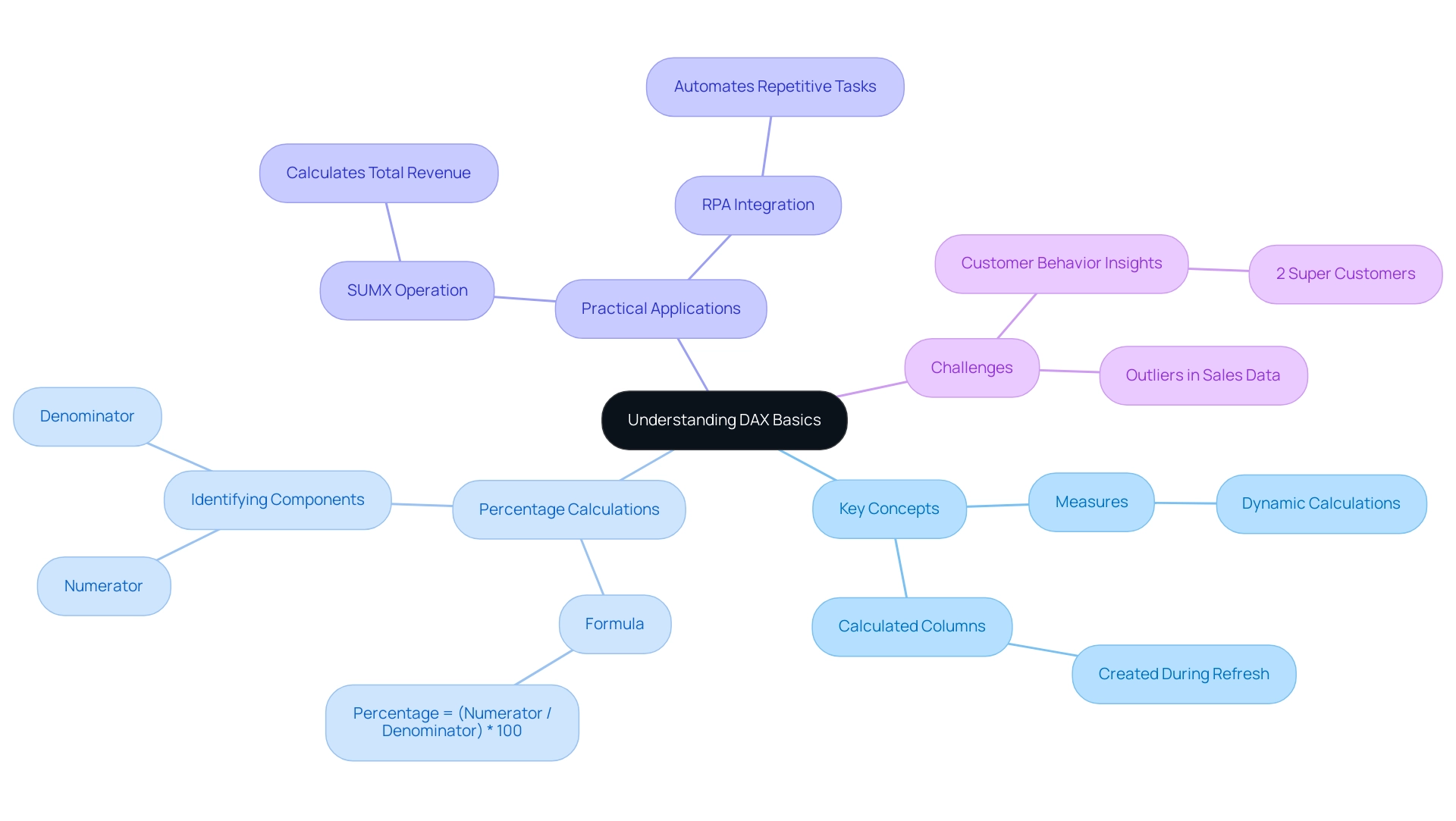
Practical Techniques for Accurate Percentage Calculations in DAX
Among the various features available in DAX, the DIVIDE tool stands out as a robust resource for calculating percentages, particularly due to its ability to gracefully manage division by zero errors—crucial in a landscape where precise information quality drives operational efficiency. In numerous organizations, the absence of data-driven insights can obstruct growth, making it crucial to employ effective DAX expressions like DIVIDE to convert raw data into actionable insights. The syntax for the DIVIDE operation is straightforward: DIVIDE(Numerator, Denominator, AlternateResult).
For instance, to compute a sales percentage in dax format percentage, you might use the expression: sales percentage = DIVIDE(SUM(Sales[Sales Amount]), SUM(Sales[Total Amount]), 0). This approach ensures that if the denominator is zero, it returns zero instead of generating an error, enhancing the reliability of your calculations, which is vital for informed decision-making. In contrast, other operations in DAX, such as volatile operations, may yield varying results each time they are invoked, highlighting the significance of utilizing DIVIDE for reliable outcomes amidst the challenges of inconsistencies frequently encountered in Power BI dashboards.
Moreover, utilizing RPA solutions such as EMMA RPA and Power Automate can enhance the application of DAX capabilities by automating information preparation processes, thereby improving operational efficiency and minimizing the laborious aspect of report creation. Additionally, utilizing the FORMAT function can significantly enhance the presentation of your results in dax format percentage. For example, you can format the sales percentage using dax format percentage by applying: Sales PercentageFormatted = FORMAT(Sales Percentage, 'Percent').
By utilizing these methods, not only do you attain accurate results, but you also improve the clarity of your reports, making the information more understandable for stakeholders. It’s noteworthy that 2% of customers become super customers within a three-year period; this statistic underscores the importance of accurate data in driving business success and operational efficiency. Moreover, the case study on the HASONEVALUE feature demonstrates how various DAX operations can be utilized for comparable tasks, emphasizing the necessity to adopt best practices such as using DIVIDE in your assessments.
Therefore, utilizing the DIVIDE function in your DAX calculations is not just a best practice but a critical step towards overcoming barriers to AI adoption and enhancing operational efficiency.
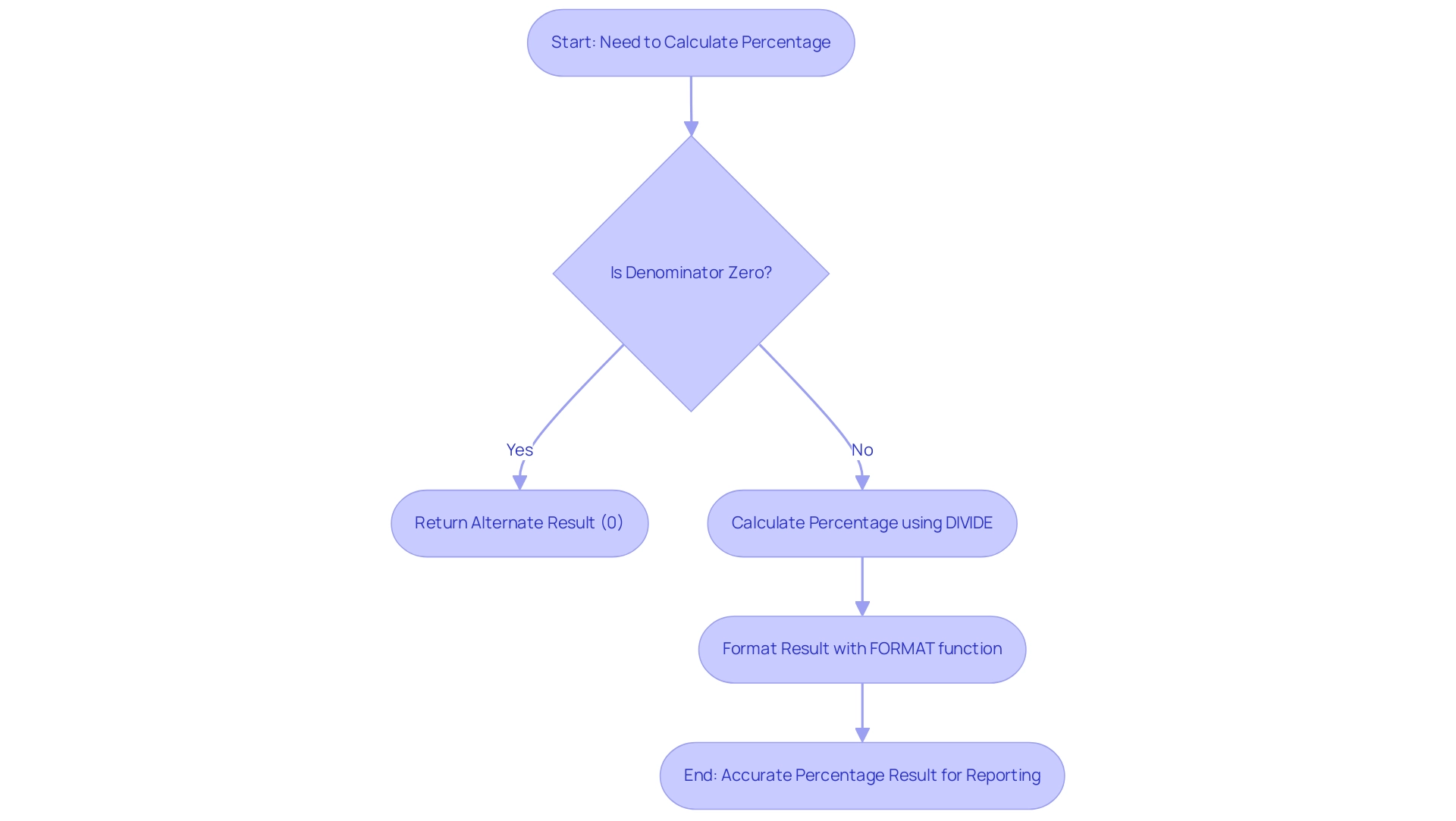
Enhancing Visuals: Conditional Formatting for Percentage Data
To enhance the interpretability of percentage information in Power BI, using dax format percentage with the implementation of conditional formatting is essential. This powerful tool enables users to highlight values according to specific criteria, facilitating the quick identification of trends and outliers—an integral aspect of harnessing Business Intelligence for informed decision-making. For effective application, begin by navigating to the Visualization pane, selecting the desired measure, and opting for ‘Conditional Formatting’.
Here, you can establish rules that alter the text or background color based on dax format percentage values. For instance, employing a gradient color scale that transitions from red (indicating low performance) to green (indicating high performance) can show a gradual increase or decrease in values at a glance, especially when represented in dax format percentage, providing immediate visual cues. As stated, ‘The next step is to apply the rules and conditions that define how the formatting will be applied to your information.’
Such techniques not only enhance information interpretation but also enable stakeholders to make informed decisions swiftly, addressing challenges like time-consuming report creation and inconsistencies. Furthermore, incorporating RPA solutions can simplify the preparation process, decreasing the time spent on report generation and ensuring consistency across dashboards. A case study titled ‘Applying Rules and Conditions in Conditional Formatting’ illustrates how the right rules and conditions can lead to complex scenarios and improved representation of significance.
The strategic application of conditional formatting acts as a catalyst for clearer communication of insights and more efficient decision-making processes, ultimately driving business growth.
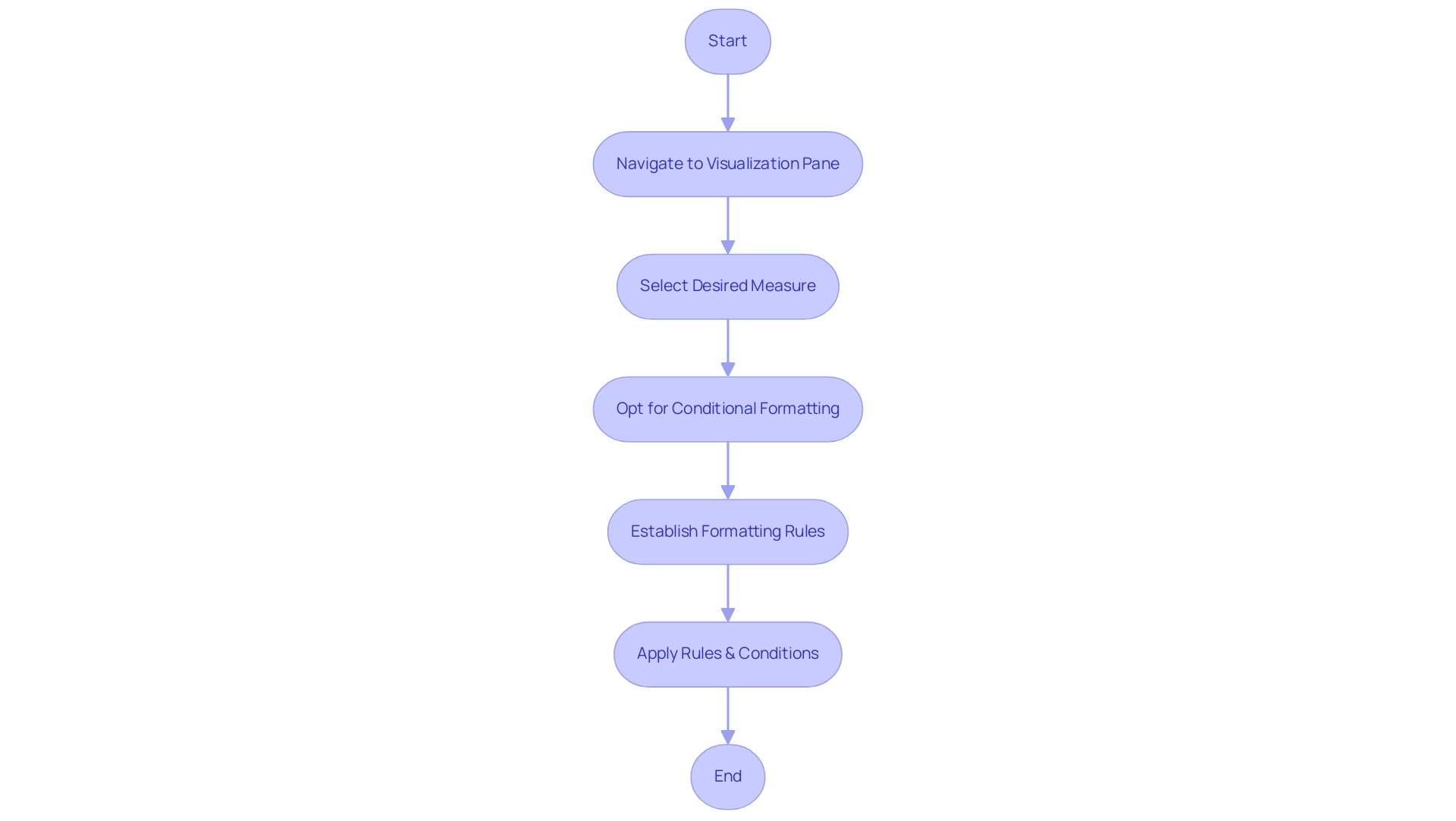
Troubleshooting Common Issues in DAX Percentage Calculations
Common issues in DAX format percentage calculations frequently arise from improper measure definitions or a lack of understanding regarding context. One prevalent error involves selecting an incorrect aggregation type, which can yield misleading results. To ensure accuracy, it is crucial to verify that measures are calculated within the appropriate context by examining the filters applied in your reports.
This challenge reflects the broader issue of leveraging insights from Power BI dashboards, where time-consuming report creation and inconsistencies can hinder effective decision-making. A relevant case study illustrates this point: when adding the estimated remaining mandays measure to a table visualization, projects with missing data disappeared, highlighting how adding a measure creates an automatic context filter that can filter out rows where the measure is blank. Another significant challenge is the risk of division by zero, a scenario that can be effectively managed by utilizing the DIVIDE operation.
This function not only prevents errors but also enhances clarity in computations, echoing the efficiency improvements offered by RPA solutions like EMMA RPA and Power Automate, which automate repetitive tasks and streamline operations. If you face unexpected outcomes, utilizing the ‘Evaluate’ feature in DAX Studio can be invaluable; it enables you to examine intermediate values step by step, assisting in identifying where computations may be faltering. To further enhance clarity, consider adding descriptions in the modeling view, providing additional context about your measures.
As Mohan Raju, DM at CorroHealth, noted, ‘Thank you for sharing, this is helpful!’ By addressing these common pitfalls with diligence and employing the right tools, you can significantly enhance the reliability of your assessments in DAX format percentage, ultimately driving data-driven insights and operational efficiency for business growth. Neglecting these issues could place your business at a competitive disadvantage, underscoring the importance of leveraging Business Intelligence effectively.
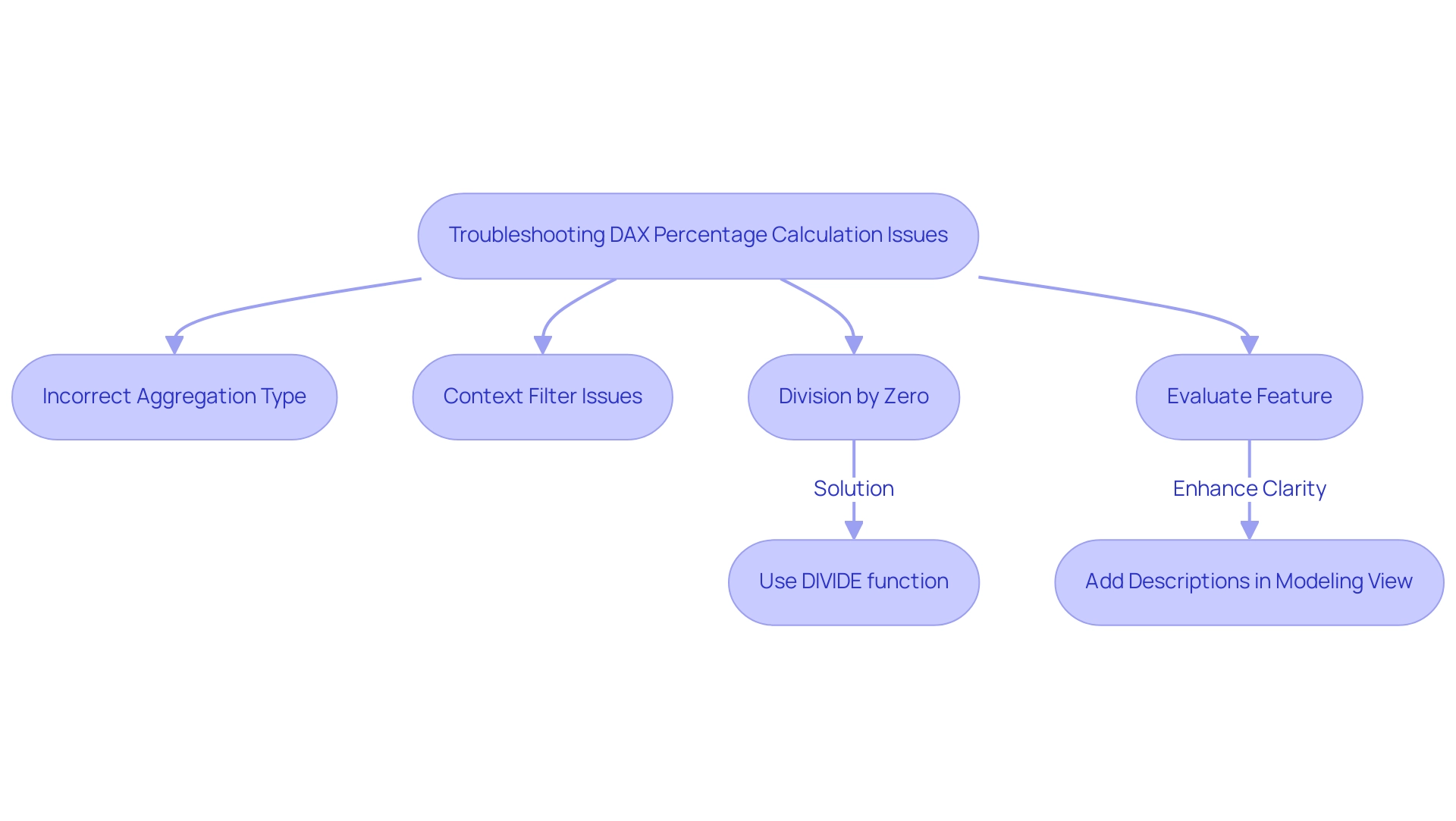
Advanced Techniques for Complex Percentage Calculations in DAX
For advanced computations in dax format percentage, utilizing the CALCULATE method along with context transition is vital. For example, when determining the dax format percentage of total sales by product category, the following formula can be used:
sales percentage by category = DIVIDE(SUM(Sales[SalesAmount]), CALCULATE(SUM(Sales[SalesAmount]), ALL(Sales[Category]))).
This formula effectively computes the sales in dax format percentage for each category against the overall total sales, irrespective of any filters applied, allowing for a clearer analysis that enhances operational efficiency.
It is important to note that you can nest up to 64 levels of functions in calculated columns, showcasing the complexity and capability of DAX formulas. Furthermore, to streamline complex computations, employing variables with the VAR keyword can significantly enhance both the readability and performance of your measures. For instance, by defining a variable for total sales within a measure, such as
VAR TotalSales = SUM(Sales[Sales Amount]),
you simplify the process of computing.
Integrating RPA solutions can further automate these data-driven processes, reducing manual workloads and enabling your team to focus on strategic initiatives. For example, automating the extraction and processing of sales information through RPA can ensure that your DAX calculations are performed on the most up-to-date details, thereby improving accuracy and efficiency. Additionally, referring to tables and columns in DAX formulas using fully qualified names, as illustrated in a relevant case study, ensures clarity and prevents errors in formula evaluation, reinforcing the importance of Business Intelligence in driving growth.
These advanced techniques not only facilitate nuanced analysis but also empower you to extract deeper insights from your data, optimizing your operational efficiency.
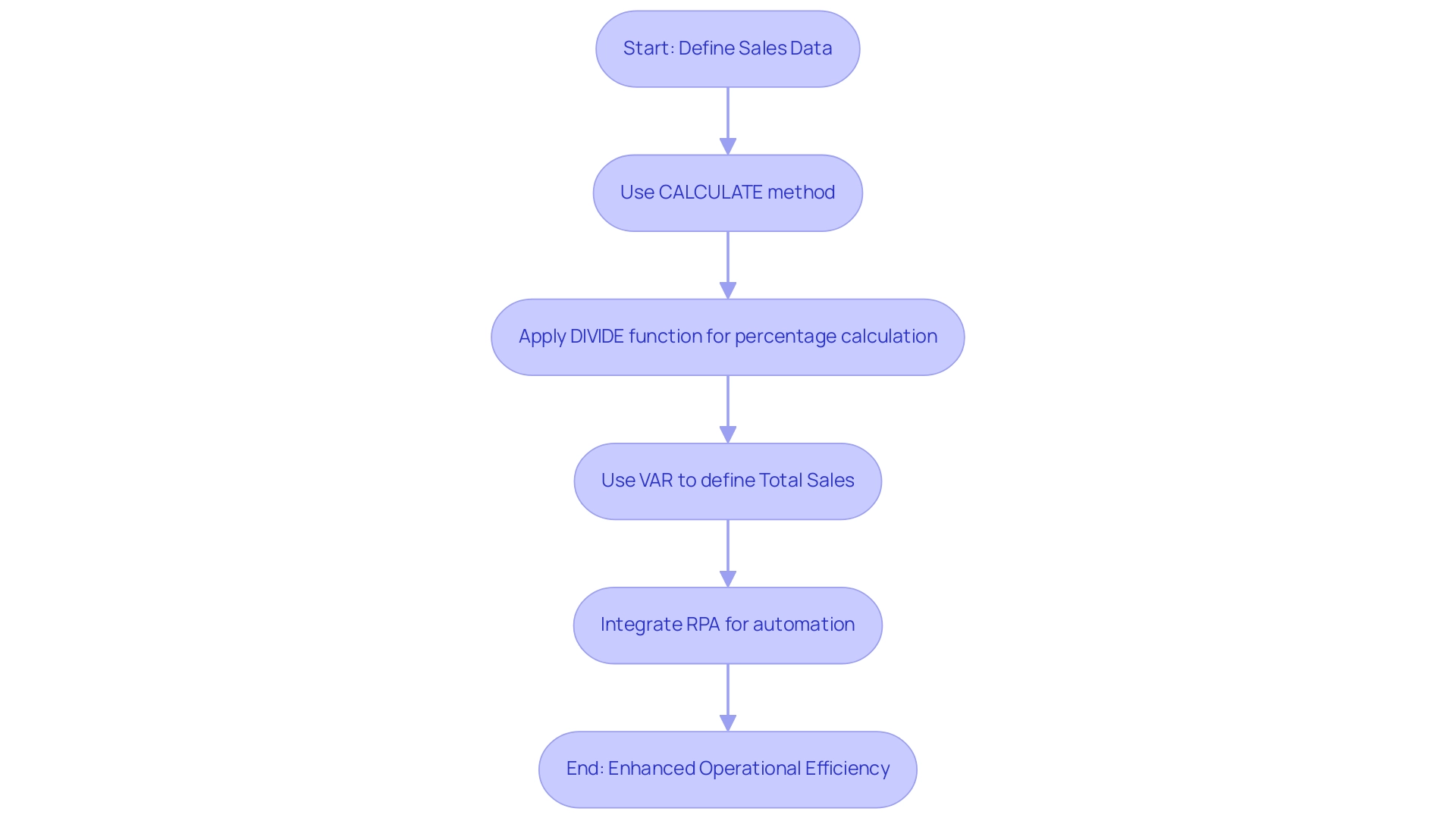
Conclusion
Mastering DAX for percentage calculations is not just a technical necessity; it is a strategic advantage that can significantly enhance data-driven decision-making. By understanding the foundational principles of DAX, including the effective use of functions like DIVIDE and SUMX, organizations can transform raw data into actionable insights. This knowledge empowers users to tackle common challenges such as data inconsistencies and time-consuming report creation, ultimately leading to improved operational efficiency.
Moreover, implementing practical techniques such as conditional formatting and RPA integration further enriches the analytical process. These tools not only provide clarity in data presentation but also streamline workflows, allowing teams to focus on strategic initiatives rather than repetitive tasks. The case studies highlighted throughout the article illustrate how adopting these practices can lead to more accurate calculations and better communication of insights.
In conclusion, leveraging DAX effectively is crucial for organizations seeking to harness the full potential of their data. By committing to continuous learning and application of advanced techniques, businesses can not only overcome obstacles but also drive growth and success in a competitive landscape. Embracing these strategies positions organizations to maximize their operational efficiency and achieve their goals with confidence.

